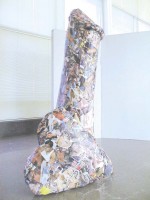
Charlie Harshman, a 49-year-old art student at Western Carolina University, reported his seven-foot-tall sculpture of a penis missing from the art display on the second floor of the Belk Building last Thursday.
It was put back on display the same day.
“I called the campus police immediately because the Art Department has had several art projects vandalized in the past,” Harshman said. “The officer left it up to the Art Department, my professor and I to settle the matter.”
The artwork is covered with magazine photo clippings of women dressed in lingerie, bikinis, etc. with their heads torn off. The heart that sits at the base of the penis has magazine photo clippings of men with their shirts off, in Speedos, some even fully clothed, but their heads are attached.
Harshman said the title of his artwork is How? Do I Love Thee.
“It’s about how the two sexes view sex-to men, sex is through the penis; girls have to have love when it comes to sex,” Harshman said. “Sex is sex for guys, and for girls, there’s usually romance involved. That makes y’all better than us.”
Dennis Depew, dean of the college of Applied Sciences, received a number of complaints from people about the artwork, according to Bob Vartabedian, dean of the College of Arts and Sciences.
Vartabedian said that Depew called Academic Affairs to get an opinion on what should be done with the piece of art.
“The big issue was that it was displayed in a very public place,” Vartabedian said. “People trying to get from point A to point B did not necessarily want to see it.”
Someone from Academic Affairs removed the piece of art, according to Vartabedian.
“When the artwork was initially removed, I think there was just some misunderstanding as to who controls that area of the Belk Building,” Vartabedian said. “It is controlled by the college of Arts and Sciences, not the college of Applied Sciences.”
According to Vartabedian, it was a tough issue because all students have rights.
“We want every student to have freedom of expression, but in this case, we also had to protect innocent bystanders who were offended by the artwork,” Vartabedian said.
Kelly Breiding, a senior at Western, was among students who did not find the artwork distasteful.
“I prefer to see more phallic symbols on campus because we should have the freedom to put them wherever we like,” Breiding said. “It’s embarrassing that a body part can be considered so obscene.”
The acting head of the Art Department, Matt Liddle, said the Art Department encourages students to express themselves openly in words and images.
“In this case, it had to do with sexuality and some people were offended by that,” Liddle said. “Students have done a lot of pieces that have some level of nudity or depiction of the human body. I haven’t run into any complaints before.”
Liddle said that the only feedback he received was positive until the artwork was removed.
“If students were offended, I was not told about it,” Liddle said. “No one complained directly to the Art Department. No one contacted the Art Department before it was removed.
“The good thing is that it generated a lot of discussion, which is good on a college campus. That is the best part about it all.”






